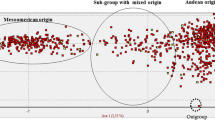Abstract
M13 DNA fingerprinting was used to determine evolutionary changes that occurred in Latin American germ plasm and USA cultivars of commonbean (Phaseolus vulgaris L.) during domestication. Linkage mapping experiments showed that M13-related sequences in the common-bean genome were either located at the distal ends of linkage groups or that they were unlinked to each other or to any previously mapped markers. Levels of polymorphism observed by hybridization with M13 (1 probe-enzyme combination) were comparable to those observed by hybridization with single-copy random PstI genomic probes (36 enzyme-probe combinations) but were higher than those observed for isozymes (10 loci). Results indicated that the wild ancestor had diverged into two taxa, one distributed in Middle America (Mexico, Central America, and Colombia) and the other in the Andes (Peru and Argentina); they also suggested separate domestications in the two areas leading to two cultivated gene pools. Domestication in both areas led to pronounced reductions in diversity in cultivated descendants in Middle America and the Andes. The marked lack of polymorphism within commercial classes of USA cultivars suggests that the dispersal of cultivars from the centers of origin and subsequent breeding of improved cultivars led to high levels of genetic uniformity. To our knowledge, this is the first crop for which this reduction in diversity has been documented with a single type of marker in lineages that span the evolution between wild ancestor and advanced cultivars.
Similar content being viewed by others
References
Balazs I, Neuweiler J, Gunn P, Kidd J, Kidd KK, Kuhl J, Mingjun L (1992) Human population genetic studies using hypervariable loci. I. Analysis of Assamese, Australian, Cambodian, Caucasian, Chinese and Melanesian populations. Genetics 131: 191–198
Becerra Velásquez VL, Gepts P (1994) RFLP diversity in common bean (Phaseolus vulgaris L.). Genome 94:256–263
Braithwaite KS, Manners JM (1989) Human hypervariable minisatellite probes detect DNA polymorphisms in the fungus Colletotrichum gloeosporioides. Curr Genet 16:473–475
Dallas JF (1988) Detection of DNA “fingerprints” of cultivated rice by hybridization with a human minisatellite DNA probe. Proc Natl Acad Sci USA 85:6831–6835
Doebley J (1989) Isozymic evidence and the evolution of crop plants. In: Soltis DE, Soltis PS (eds) Isozymes in plant biology. Dioscorides, Portland, Ore. pp 165–191
Doebley J (1992) Molecular systematics and crop evolution. In: Soltis PS, Soltis DE, Doyle JJ (eds) Molecular systematics of plants. Chapman Hall, New York, pp 202–222
Donis-Keller H, Barker DF, Knowlton RG, Schumm JW, Braman JC, Green P (1986) Highly polymorphic RFLP probes as diagnostic tools. Cold Spring Harbor Symp Quant Biol 51: 317–324
Feinberg AP, Vogelstein B (1984) Addendum: a technique for radiolabelling DNA restriction endonuclease fragments to high specific activity. Anal Biochem 137:266–267
Fisher RA (1930) The genetic theory of natural selection. Dover, New York
Gepts P (1988) A Middle American and Andean gene pool. In: Gepts P (ed) Genetic resources of Phaseolus beans. Kluwer, Dordrecht, the Netherlands, pp 375–390
Gepts P (1990) Biochemical evidence bearing on the domestication of Phaseolus beans. Econ Bot 44:28–38
Gepts P (1993a) Linkage map of common bean (Phaseolus vulgaris L.). In: O'Brien SJ (ed) Genetic maps. Cold Spring Harbor Laboratory, Cold Spring Harbor, N.Y. pp 6.101–6.109
Gepts P (1993b) The use of molecular and biochemical markers in crop evolution studies. Evol Biol 27:51–94
Gepts P, Bliss FA (1986) Phaseolin variability among wild and cultivated common beans (Phaseolus vulgaris) from Colombia. Econ Bot 40:469–478
Gepts P, Osborn TC, Rashka K, Bliss FA (1986) Phaseolin-protein variability in wild forms and landraces of the common bean (Phaseolus vulgaris): evidence for multiple centers of domestication. Econ Bot 40:451–468
Gepts P, Kmiecik K, Pereira P, Bliss FA (1988) Dissemination pathways of common bean (Phaseolus vulgaris, Fabaceae) deduced from phaseolin electrophoretic variability. I. The Americas. Econ Bot 42:73–85
Gepts P, Nodari R, Tsai R, Koinange EMK, Llaca V, Gilbertson R, Guzmán P (1993) Linkage mapping in common bean. Annu Rep Bean Improv Coop 36:xxiv-xviii
Golding GB, Aquadro CF, Langley CH (1986) Sequence evolution within populations under multiple types of mutation. Proc Natl Acad Sci USA 83:427–431
Haldane JBS (1927) A mathematical theory of natural and artificial selection, part V. Selection and mutation. Proc Camb Philos Soc 23:838–844
Harlan JR (1992) Crops and man. American Society of Agronomy, Madison, Wis.
Hillel J, Schaap T, Haberfeld A, Jeffreys AJ, Plotzky Y, Cahaner A, Lavi U (1990) DNA fingerprints applied to gene introgression in breeding programs. Genetics 124:783–789
Hoyt E (1988) Conserving the wild relatives of crops. International Board for Plant Genetic Resources, Rome
Jeffreys AJ, Wilson V, Thein SL (1985) Hypervariable ‘minisatellite’ regions in human DNA. Nature 314:67–73
Jeffreys AJ, Wilson V, Kelly R, Taylor BA, Bulfield G (1987) Mouse DNA ‘fingerprints’: analysis of chromosome localization and germ-line stability of hypervariable loci in recombinant inbred strains. Nucleic Acids Res 15:2823–2836
Kimura M (1983) The neutral theory of molecular evolution. Cambridge University Press, Cambridge, UK
Koenig R, Gepts P (1989) Allozyme diversity in wild Phaseolus vulgaris: further evidence for two major centers of diversity. Theor Appl Genet 78:809–817
Koenig R, Singh SP, Gepts P (1990) Novel phaseolin types in wild and cultivated common bean (Phaseolus vulgaris, Fabaceae). Econ Bot 44:50–60
Koinange EMK, Gepts P (1992) Hybrid weakness in wild Phaseolus vulgaris L. J Hered 83:135–139
Kornegay J, Cardona C, Posso CE (1993) Inheritance of resistance to Mexican bean weevil in common bean, determined by bioassay and biochemical tests. Crop Sci 33:589–594
Kuhnlein U, Dawe Y, Zadworny D, Gavora JS (1989) DNA finger-printing: a tool for determining genetic distances between strains of poultry. Theor Appl Genet 77:669–672
Ladizinsky G (1985) Founder effect in crop-plant evolution. Econ Bot 39:191–198
Lander ES, Green P, Abrahamson J, Barlow A, Daly M, Lincoln SE, Newburg L (1987) MAPMAKER: an interactive computer package for constructing primary genetic linakge maps of experimental and natural populations. Genomics 1:174–181
McClean PE, Myers JR, Hammond JJ (1993) Coefficient of parentage and cluster analysis of North American dry bean cultivars. Crop Sci 33:190–197
Nakamura Y, Leppert M, O'Connell P, Wolff R, Holm T, Culver M, Martin C, Fujimoto E, Hoff M, Kumlin E, White R (1987) Variable number of tandem repeat (VNTR) markers for human gene mapping. Science 235:1616–1622
Nei M (1987) Molecular evolutionary genetics. Columbia University Press, New York
Nodari RO, Koinange EMK, Kelly JS, Gepts P (1992). Towards an integrated linkage map of common bean I. Development of genomic DNA probes and levels of restriction fragment length polymorphism. Theor Appl Genet 84:186–192
Nodari RO, Tsai SM, Gilbertson RL, Gepts P (1993) Towards an integrated linkage map of common bean. II. Development of an RFLP-based linkage map. Theor Appl Genet 85:513–520
Nybom H, Hall HK (1991) Minisatellite DNA ‘fingerprints’ can distinguish Rubus and estimate their degree of relatedness. Euphytica 53:107–114
Nybom H, Rogstad SH (1990) DNA “fingerprints” detect genetic variation in Acer negundo (Aceraceae). Plant Syst Evol 173:49–56
O'Connell P, Lathrop GM, Nakamura Y, Leppert ML, Ardinger RH, Murray JC, Lalouel J-M, White R (1989) Twenty-eight loci form a continuous linkage map of markers for human chromosome 1. Genomics 4:352–360
Reeve HK, Westneat DF, Noon WA, Sherman PW, Aquadro CF (1990) DNA “fingerprinting” reveals high levels of inbreeding in colonies of the eusocial naked mole-rat. Proc Natl Acad Sci USA 87:2496–2500
Rogstad SH, Patton JC II, Schaal BA (1988) M13 repeat probe detects DNA minisatellite-like sequences in gymnosperms and angiosperms. Proc Natl Acad Sci USA 85:9176–9178
Rohlf FJ (1991) NTSYS-pc. Exeter Software, Setauket, N.Y.
Royle NJ, Clarkson RE, Wong Z, Jeffreys AJ (1988) Clustering of hypervariable minisatellites in the proterminal regions of human autosomes. Genomics 3:352–360
Sambrook J, Fritsch E, Maniatis T (1989) Molecular cloning. Cold Spring Harbor Laboratory Press, Cold Spring Harbor, N.Y.
Simmonds NW (1976) Evolution of crop plants. Longman, London
Singh SP, Gepts P, Debouck DG (1991a) Races of common bean (Phaseolus vulgaris L., Fabaceae). Econ Bot 45:379–396
Singh SP, Nodari R, Gepts P (1991b) Genetic diversity in cultivated common bean. I. Allozymes. Crop Sci 31:19–23
Sneath PHA, Sokal R (1973) Numerical taxonomy. Freeman, San Francisco, Calif.
Stockton T, Sonnante G, Gepts P (1992) Detection of minisatellite sequences in Phaseolus vulgaris. Plant Mol Biol Rep 10:47–59
Vassart G, Georges M, Monsieur R, Brocas H, Lequarre AS, Christophe D (1987) A sequence of M13 phage detects hypervariable minisatellites in human and animal DNA. Science 235:683–684
Wells RA, Green P, Reeders ST (1989) Simultaneous genetic mapping of multiple human minisatellite sequences using DNA fingerprinting. Genomics 5:761–772
Wyman AR, White R (1980) A highly polymorphic locus in human DNA. Proc Natl Acad Sci USA 77:6754–6758
Author information
Authors and Affiliations
Additional information
Communicated by A. R. Hallauer
Rights and permissions
About this article
Cite this article
Sonnante, G., Stockton, T., Nodari, R.O. et al. Evolution of genetic diversity during the domestication of common-bean (Phaseolus vulgaris L.). Theoret. Appl. Genetics 89, 629–635 (1994). https://doi.org/10.1007/BF00222458
Received:
Accepted:
Issue Date:
DOI: https://doi.org/10.1007/BF00222458




